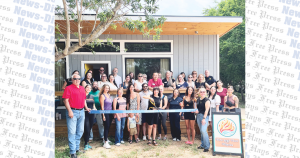
WIMBERLEY — A new residential development is coming to the city of Wimberley, but this time, it’s going to be filled with 3D printed homes.
WIMBERLEY — A new residential development is coming to the city of Wimberley, but this time, it’s going to be filled with 3D printed homes.
ICON, a company that is considered to be a leader in advanced construction technologies pioneering 3D printing robotics, announced that its newest homes will be in the Wimberley Springs neighborhood and they are already available for sale. The eight single-family residential homes feature designs from ICON’s digital architecture catalog and range from four to five bedrooms and 2,900 to 4,100 square feet.
In 2018, the founders behind ICON — Jason Ballard, Alex Le Roux and Evan Loomis — told people that they were going to 3D print homes during South by Southwest in Austin before they knew how to do that. Partnering with a housing nonprofit, New Story, they delivered the world’s first permitted, 3D-printed home.
Today, ICON has 3D printed more than 140 homes and structures across the U.S. and Mexico, including Texas cities Georgetown, Marfa and, now, Wimberley.
“I love Wimberly so much. It’s like a serene escape so close to Austin, but you still feel like you are in a beautiful forest [with] so many water features everywhere. The land was just too hard to pass up. For ICON, this is the first set of homes that we’re delivering in a community and we are doing everything from start to finish: design, build, finish out and then sell to customers,” explained ICON Vice President of Marketing & Communications Brooke Bauguess. “It’s our first direct homeowner experience at ICON and we couldn’t have picked a better spot to do that … It’s just so special there. We’re really happy to be a part of Wimberley.”
ICON exists to address the global housing crisis in both affordability as well as the availability of homes. The company currently has projects that are being built across social and affordable housing, mainstream residential and hospitality/commercial developments.
“I think the latest statistic was 5.5 million people in the U.S. don’t have adequate shelter, and then across the globe, it’s like 1.2 billion. If we keep building things traditionally, we’re not going to get there to be able to build a billion homes. One of the things ICON always says is that we need to be doing things differently and the housing of the future must be different from the housing we’ve known,” Bauguess said.
The company uses a 9,600-pound construction robot — a Gantry style for 3D printing — so that when the team shows up to the project it’s like “bringing the factory right to the job site,” Bauguess described.
“We set up the printer very quickly on rails, it operates back and forth, and we’ll start extruding our concrete material and building up the home in the wall system, layer by layer. It’s quite mesmerizing to watch, but we extrude the material and it builds up and we build up to 10 feet tall. Once the construction process is done for the wall system, that’s when, you know, your standard trades would come in to do roof, windows, doors, plumbing [and] electrical, but all of that is mapped out in the digital design of the home,” she said. “It’s all about speed, efficiency and more autonomy, so that you’re able to deliver a full wall system that [when] traditionally built, would have called for like six to eight different steps in the process [to coordinate] all those trades and the time to do that. [But] with 3D printing, you’re able to do it in one step and, as a result, that wall system is much more durable, resilient and energy efficient in the end. You’re getting a better home and you’re getting it faster.”
Features of the 3D printed homes in Wimberley, according to ICON, include:
• High thermal performance: The concrete construction of the homes provide thermal mass that slows heat transfer in and out of the home, allowing the structure to better withstand temperature swings without increasing air conditioning or heating costs.
• Energy efficiency: Homes will be certified to the Energy Star home standard developed by the U.S. Environmental Protection Agency. ICON homes typically receive a Home Energy Rating System rating between 40-55, meaning ICON homes may be 45-60% more energy efficient than a standard new home.
• Sustainably built: ICON’s proprietary low-carbon material CarbonX, when paired with ICON’s wall system and robotic construction methods, is the lowest carbon residential building system to be used at scale.
• Strength and durability: The printed wall system of ICON homes have been tested to withstand wind speeds of up to 250 mph.
• Smart home equipped: Smart thermostats for energy efficient operation and a smart video doorbell are installed.
“Something has to change to be able to provide shelter without harming the Earth, but also resilient shelter … Homes get wiped out in the wake of a natural disaster and we’re still rebuilding those homes with the same materials. With the 3D printing, our material and the durability of our homes, it’s a superior home that is designed to withstand 250 mile per hour winds [and they have] a nearly three-hour fire rating,” Bauguess continued. “These homes are durable and resilient and designed to not be food for mold, termites and mildew. This is, long term, a better solution for homeowners. We’re [also] already seeing homeowners share with us that their energy bills are much lower than if they were living in a traditionally built home.”
The only challenge that ICON has faced so far in installing 3D-printed homes is not being able to keep up with the high demand of requests, Bauguess said.
“We’re almost a 7-year-old company and we have requests coming all over the place, especially after a fire or a hurricane and people needing homes faster and more durable. It’s been hard to not be able to just jump on everything and say yes. That demand, I’d say, has been kind of the hardest thing so far,” she explained. “But with regards to constructability, permitting and building, the only struggle is we just would love for cities to be able to even go faster. It takes a long time for anyone to build anywhere and so the timeframe to truncate that, to be able to deploy our construction method anywhere in the world and faster, I’d say that’s been a hurdle. The faster we can get more homes on the ground, the faster we can solve the housing crisis for those millions of people that lack adequate shelter here in the U.S.”
The homes in Wimberley are now available for sale starting at more than $800,000; the home prices are determined based on fair market value, according to ICON.
To learn more about ICON and its projects, visit www.iconbuild.com.













